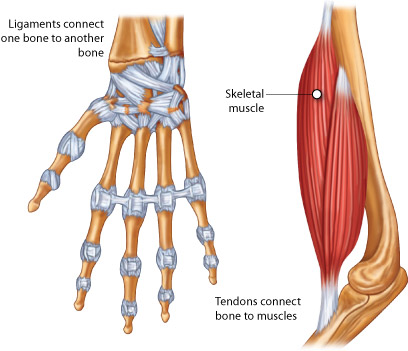6.1 Skeletal Introduction
Learning Objectives
- Identify gross and microscopic structural components of the skeletal system
- Correlate the structural components of the skeletal system with their functions
- Identify the major chemical components of the skeletal system
- Illustrate the relationships among the components of the skeletal system
- Summarize the functions of the skeletal system
- Correlate joint structure with joint movement
Skeletal Introduction[1]
The skeletal system consists of bones, cartilage, ligaments, and tendons that form the strong internal framework of the human body.
Bones support the weight of the body, allow for body movements, and protect internal organs. An adult human body has 206 bones. Each bone in the body serves a particular function; therefore, bones vary in size, shape, and strength based on these functions. For example, the bones of the lower back and lower limb are thick and strong to support body weight. Similarly, the size of a bony landmark that serves as a muscle attachment site on an individual bone is related to the strength of the muscle.
Bones change in strength and thickness in response to changes in muscle strength or body weight. Muscle attachment sites on bones thicken if there is an increase in muscle strength, such as beginning a new weightlifting program. Similarly, the walls of weight-bearing bones will thicken if there is an increase in body weight or a new exercise program. In contrast, loss of muscle strength or body weight will cause bones to become thinner. This may happen during a prolonged hospital stay, following limb immobilization in a cast, or going into the weightless environment of outer space. Even a change in diet, such as eating only soft food due to the loss of teeth, will result in a noticeable decrease in the size and thickness of the jaw bones.
Cartilage provides flexible strength and support for body structures such as the rib cage, the external ear, and the trachea. In joints, cartilage can also connect bones or provide cushioning between them. Ligaments are strong connective tissue bands that connect bones to other bones. Tendons firmly attach muscles to bones. As muscles contract, they pull on the bones to produce movements of the body. See Figure 6.1[2] for an illustration comparing ligaments and tendons.

This chapter will discuss the structure and function of bones and joints, as well as disorders affecting the skeletal system.
View a supplementary YouTube video[3] of an overview of the skeletal system: Skeletal System.
- Ernstmeyer, K., & Christman, E. (Eds.). (2024). Medical terminology 2e. Open RN | WisTech Open. https://wtcs.pressbooks.pub/medterm/ ↵
- “tendon-lig.jpg” by unknown author is licensed under CC BY-SA 4.0. Access for free at https://pressbooks.ccconline.org/bio106/chapter/skeletal-structures-and-functions/ ↵
- Amoeba Sisters. (2023, June 7). Skeletal system [Video]. YouTube. All rights reserved. https://www.youtube.com/watch?v=m26gr04HIVE ↵
A strong, flexible connective tissue that protects your joints and bones.
Strong connective tissue bands that connect bones to other bones.
A fibrous connective tissue that attaches muscle to bone.

